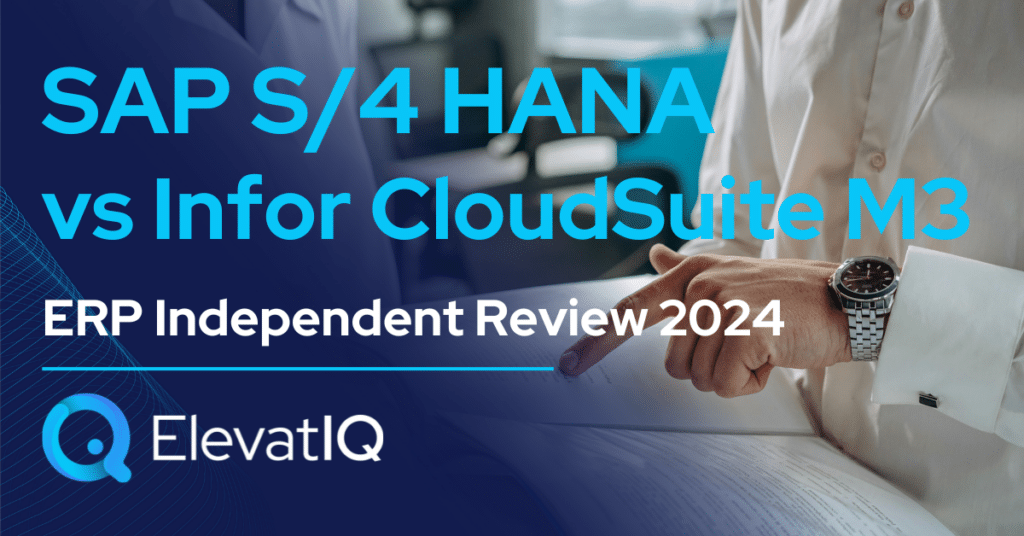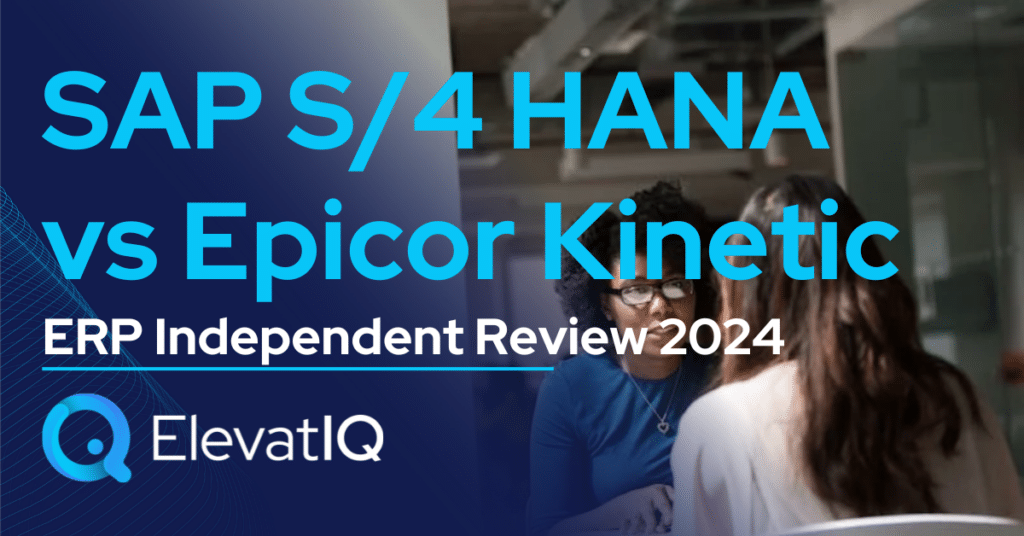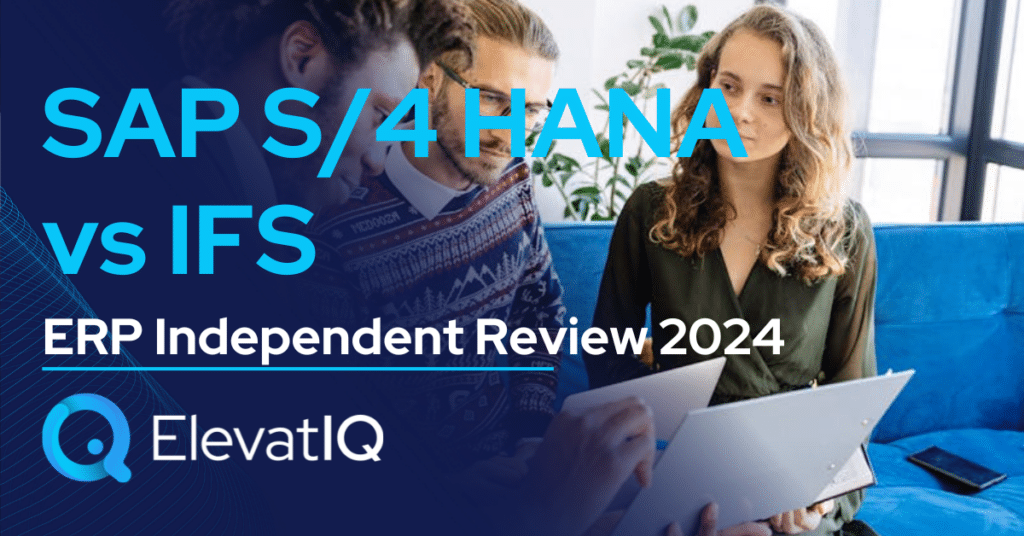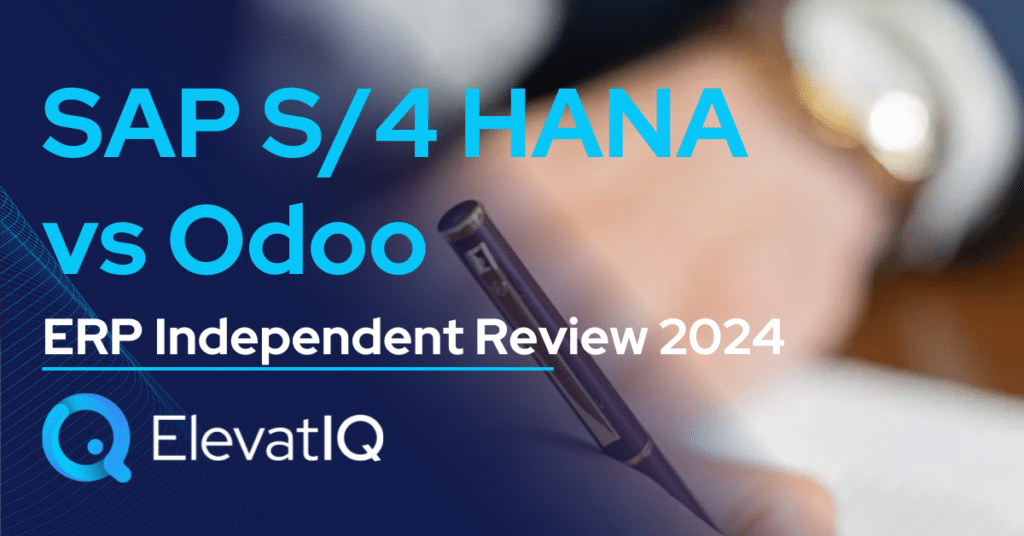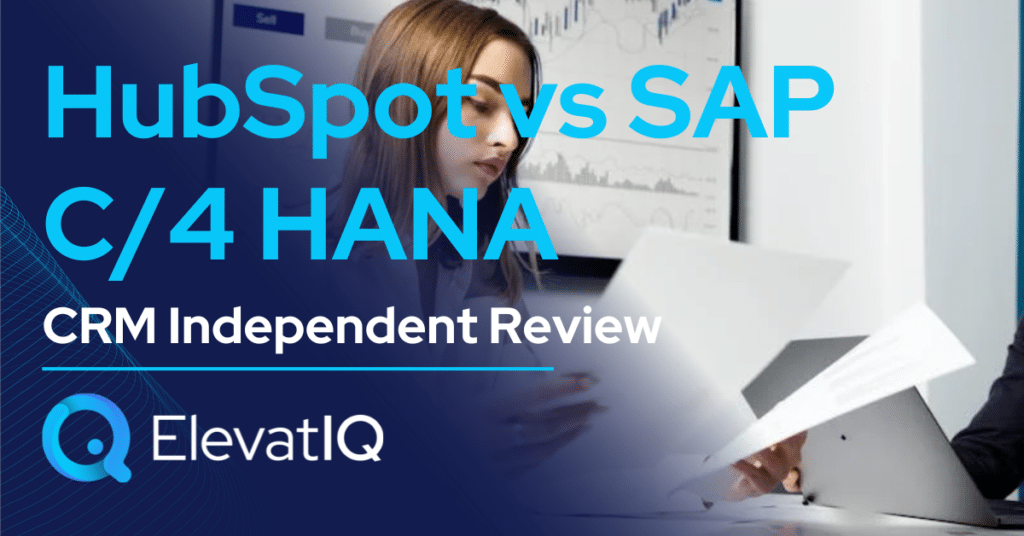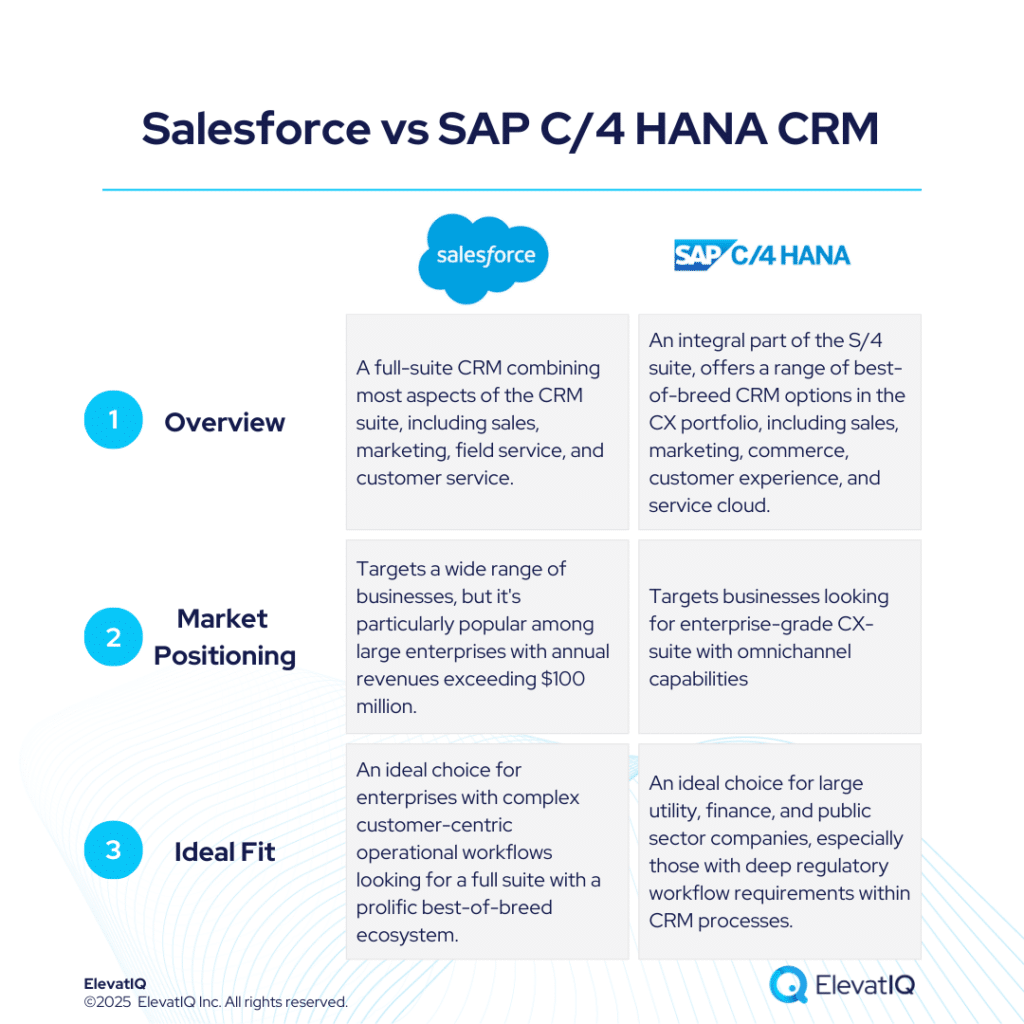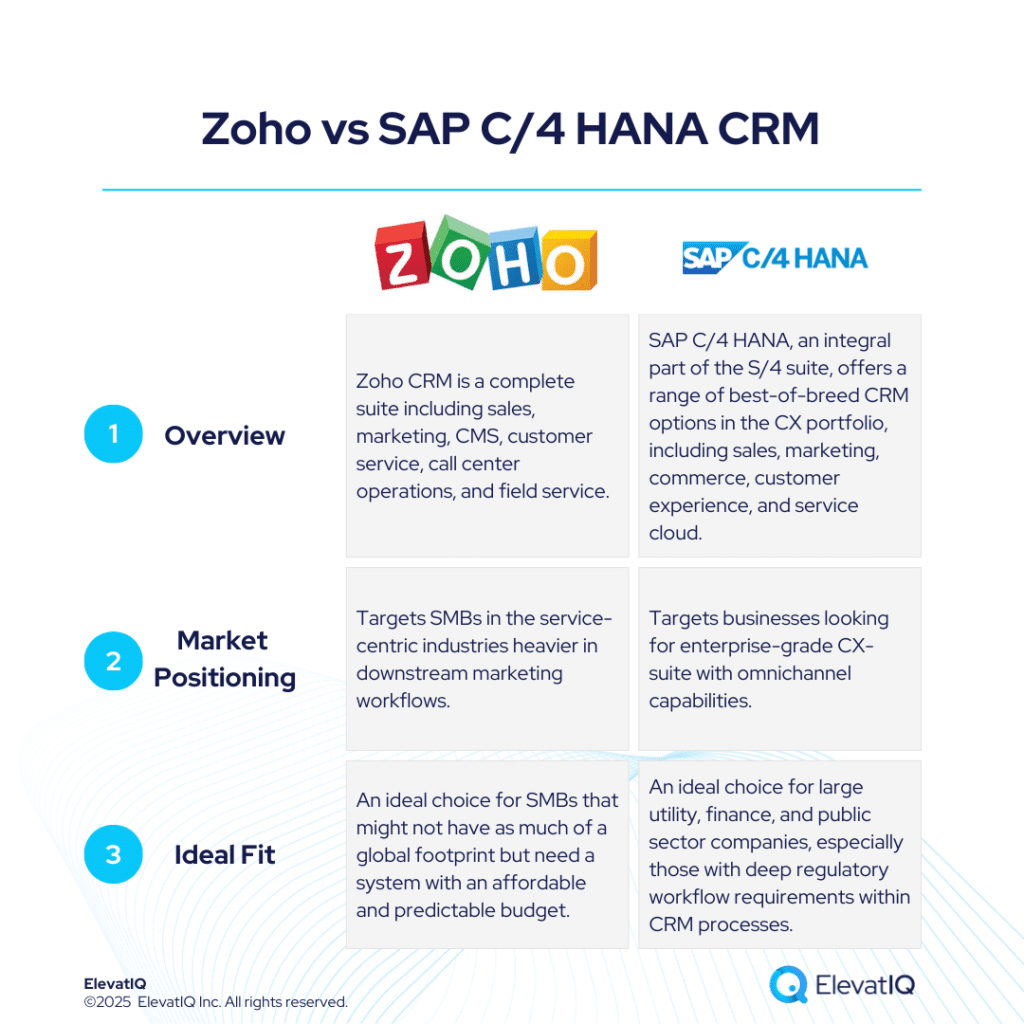Last Updated on September 19, 2024 by Shrestha Dash
SAP maintains its dominance in the ERP market, largely due to its stronghold in the enterprise segment where deals are significantly larger compared to the mid-market. The architecture complementing the S/4 HANA Suite is particularly favored by enterprise-grade companies, offering leading products like SuccessFactors, Hybris, EWM, Ariba, and Concur. On the other hand, Infor CloudSuite M3 targets companies surpassing entry-level ERP systems like Acumatica, Infor CSI, or NetSuite. It also delivers mature capabilities for intricate manufacturing and distribution operations.
SAP S/4 HANA targets larger companies with revenues exceeding $1B and with a substantial global presence, aiming to keep all global entities in one system. Whereas, Infor CloudSuite M3 is successful in the upper mid-market, targeting the $250M – $750M revenue range. SAP S/4 HANA often becomes a default choice for enterprise companies due to high transaction volumes, stringent governance, and traceability needs. It particularly shines in product-centric enterprises requiring robust capabilities like MRP and allocation for global workloads. Infor CloudSuite M3 provides a superior suite experience akin to SAP and Oracle, featuring enterprise-grade best-of-breed functionalities, including PLM, WMS, WFM, BI, and a Supply Chain collaboration platform.
Infor CloudSuite M3 also boasts extensive features tailored for process and apparel manufacturing, covering industries such as fashion, F&B, and chemicals. It is also adept at facilitating advanced global operations, particularly for companies spanning multiple countries seeking to optimize cost synergies globally. Choosing between SAP S/4 HANA vs Infor M3 requires a detailed examination, and thus, this comparison offers valuable insights for ERP selection projects. Therefore, let’s explore further.
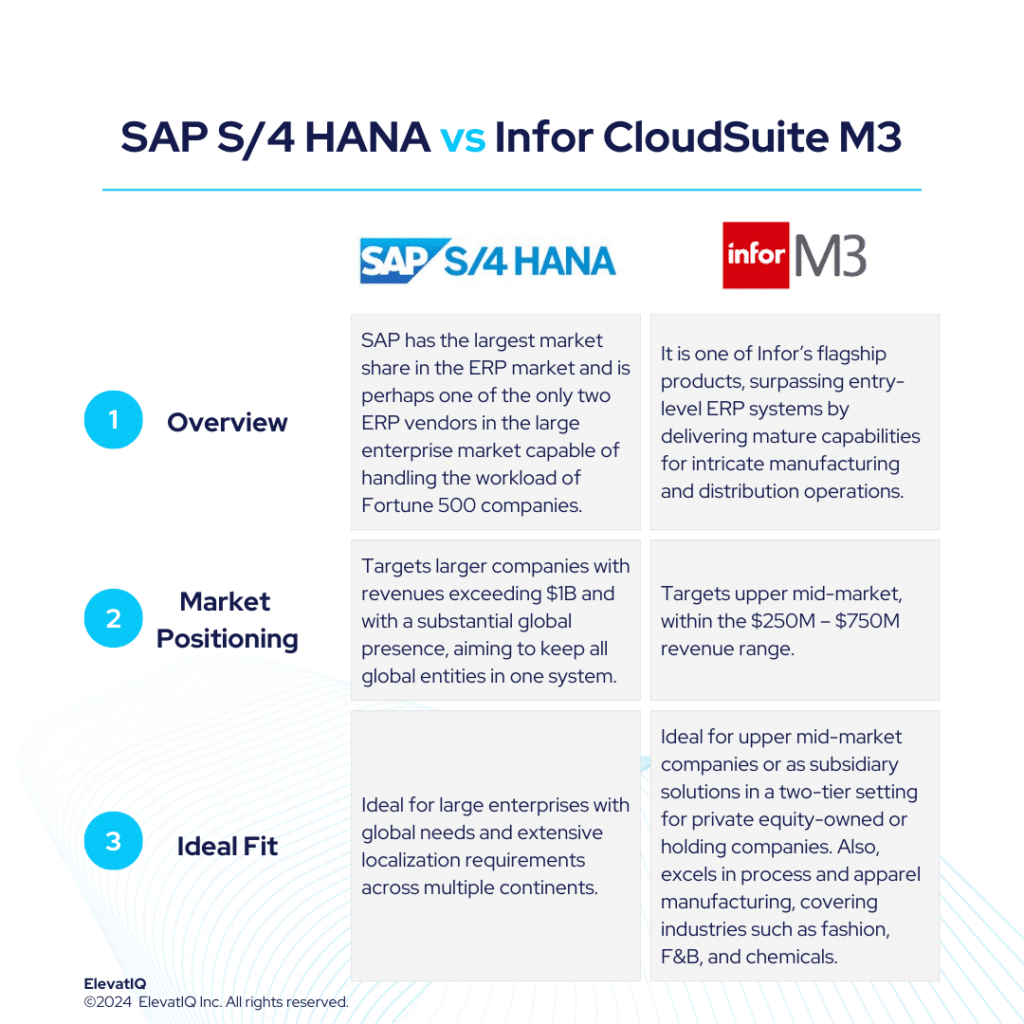

| SAP S/4 HANA | Infor CloudSuite M3 | |
| Started in | Pioneers of ERP | 2006 (Acquired by Infor) |
| Ownership by | SAP | Koch Industries |
| No. of customers | 28,000+ | 1000+ |
What Is SAP S/4 HANA?
SAP S/4 HANA remains the top choice for large enterprises with global needs and extensive localization requirements across multiple continents. In this league, its primary rival is Oracle. While alternatives like Unit4, IFS, or Deltek might handle the workload for larger enterprises, they often lack the robust global compliance and transactional capabilities that SAP S/4 HANA offers. Additionally, SAP S/4 HANA excels in providing superior transactional workflow capabilities that are purpose-built to streamline traceability for large and complex organizations.
Moreover, SAP S/4 HANA is an ideal choice for companies seeking a best-of-breed architecture tailored to the needs of specific functions. This architecture allows for operational cores on different ledgers, which is crucial for larger distribution and 3PL companies managing complex WMS networks. Companies with intricate HCM operations and stringent compliance requirements may find it necessary to integrate a best-of-breed system.
Additionally, for enterprises requiring sophisticated eCommerce platforms with components like CDP or CPQ, SAP S/4 HANA provides the essential capabilities. The flexibility and enterprise-grade best-of-breed architecture make SAP S/4 HANA a standout solution for such diverse operational needs. The cloud version may require additional third-party add-ons, similar to NetSuite. Nevertheless, organizations opting for the on-prem version can access superior capabilities, potentially outperforming other ERP systems.
What Is Infor CloudSuite M3?
Infor CloudSuite M3, is one of Infor’s flagship solutions, catering to particularly distinct micro-verticals across various industries. Sharing similar suites with Infor LN and also built on the Infor OS platform, it is successful in the upper mid-market, targeting the $250M – $750M revenue range. Positioned for companies surpassing entry-level ERP systems like Acumatica, Infor CSI, or NetSuite, this solution delivers mature capabilities for intricate manufacturing and also distribution operations. Infor CloudSuite M3 provides a superior suite experience akin to SAP and Oracle thus, featuring enterprise-grade best-of-breed functionalities, including PLM, WMS, WFM, BI, and a Supply Chain collaboration platform.
Infor CloudSuite M3 boasts extensive features tailored for process manufacturing and apparel manufacturing, covering industries such as fashion, F&B, and chemicals. It is also adept at facilitating advanced global operations, particularly for companies spanning multiple countries seeking to optimize cost synergies globally. The native capabilities of Infor M3 address global trade and compliance concerns, which are particularly crucial for international business operations.
While Infor CloudSuite M3 serves as an excellent operational solution for a 2-tier architecture for enterprise companies, its limited focus on certain industries might not be the best fit for enterprise companies diversifying their operations or aggressive with their M&A strategy. The intricate data model and Bill of Materials (BOM) demand significant internal expertise and also external advisory assistance to extract operational efficiencies. Notably, the technology landscape for Infor CloudSuite M3 remains somewhat patchy and less modern compared to its competitors. Furthermore, the ecosystem and consulting support for this solution is relatively limited. Despite these challenges, Infor CloudSuite M3 stands out as a robust manufacturing solution for upper mid-market companies with budget constraints.
SAP S/4 HANA vs Infor M3 Comparison
Navigating the choice between SAP S/4 HANA vs Infor M3 is a significant decision for businesses particularly looking for operational efficiency and strategic alignment. Thus, this section delves into the comprehensive comparison of SAP S/4 HANA vs Infor M3 across various critical dimensions.
| SAP S/4 HANA | Infor CloudSuite M3 | |
| Global Operational Capabilities | Deeper multi-entity capabilities; widely installed globally. | Robust financial hierarchies and global trade compliance functionality integrated. |
| Diverse Capabilities | Handles diverse business models; may require add-ons for deeper capabilities. | Supports diversified manufacturing business models. |
| Best-of-breed Capabilities | Pre-integrated enterprise apps; augmented by third-party add-ons. | Best-of-breed integrations provided out-of-the-box. |
| Last-mile Capabilities | Limited last-mile capabilities; may need add-ons for micro-verticals. | Last-mile capabilities along with breadth of capabilities for diversified manufacturing business models. |
| Operational Functionalities | Enterprise-grade operational capabilities; industry-specific features limited. | Infor CloudSuite M3 is a legacy solution with limited cloud-natve capabilities such as universal search, mobile experience, etc. |
| Integration Capabilities | Has several tools pre-integrated as part of the architecture but industry-specific integrations such as CAD, PLM, etc require third-party add-ons. | Tools such as HCM, PLM, data lake, ERP, WMS, TMS, and advanced supply chain planning, are all pre-integrated. |
| Manufacturing Capabilities | Complex capabilities; industry-specific limitations. | Delivers mature capabilities for apparel, F&B, and chemical manufacturing. |
| Pricing Model | FUE (Full Use Equivalent) | Subscription-based |
| Key Modules | 1. Financial Management 2. Sales 3. Procurement 4. Manufacturing Management 5. Supply Chain Management 6. Professional Services Automation 7. CRM | 1. Financial Management 2. Manufacturing Operations 3. Enterprise Asset Management 4. Supply Chain Management 5. Customer Sales and Service 6. Application Foundation |
SAP S/4 HANA vs Infor M3 Feature Comparison
Both platforms offer a plethora of features and functionalities designed to streamline business operations and enhance efficiency. In this feature comparison, we delve into particularly the distinct capabilities of SAP S/4 HANA vs Infor M3 across various critical dimensions, providing insights to aid businesses in making informed decisions regarding their ERP selection. Thus, this section discusses features under each of the following modules, particularly financial management, supply chain management, and manufacturing management.
Financial Management Comparison
In this section, we are discussing a detailed comparison of the financial management capabilities particularly offered by SAP S/4 HANA vs Infor M3. By examining their respective strengths and functionalities, particularly in managing financial processes. Businesses can therefore gain valuable insights to determine the best-suited ERP solution for their financial management needs.
| SAP S/4 HANA | Infor CloudSuite M3 | ||
| Financial Management | General Ledger | Can support the needs of even the most complex financial organizations with more than ten ledger rollups at the country level and conversions. | Enables organizations to manage financial transactions, maintain accurate balances, and generate complete financial statements. |
| Accounts Receivable and Accounts Payable | Supports global collaboration of customers and vendors, including shared service model. | Supports analysis across all accounting dimensions, including non-reconciled data for the AP model. | |
| Cash Flow Management | Complex treasury capabilities with support for global operations, including maintaining treasury KPIs, workflows, and processes for dedicated treasury departments. | Provides complete control over accounts receivable and cash flow processes, unifying all AR information to monitor cash collection and enhance productivity and efficiency. | |
| Currency Management | Can support complex currency workflows such as hedging and planning for current impact on different financial statements and accounts globally. | Enables currency conversion for better monetary analysis, allowing amounts to be expressed in transaction, division, and company currencies, with a default exchange rate type for conversions. | |
| Tax Management | Has built-in support for taxes in over 100 countries. | Ensures accurate VAT calculation and recording for each country, automating tax calculations based on recipient location and country-specific rules, and maintaining financial compliance. |
Supply Chain Management Comparison
In this comparison, we explore and analyze the supply chain management capabilities of SAP S/4 HANA vs Infor M3, shedding light particularly on their respective strengths and weaknesses.
| SAP S/4 HANA | Infor CloudSuite M3 | ||
| Supply Chain Management | Warehouse Management | Can support embedded or standalone architectural patterns along with complex business models such as 3PL or warehouse value-added services for third-party logistics. | Optimizes operations with inventory management, labor management, 3PL billing, and 3D visualization, enhancing efficiency and interactivity. |
| Service Management | Can support complex quotes and service scheduling workflows of globally operated companies with large crews of field workers with scheduling dependencies of global operations. | Offers work order processing, maintenance, material management, and operation reporting, aiding global manufacturers, distributors, and after-sales service providers in managing complex value chains efficiently. | |
| Inventory Management | Robust inventory management capabilities accommodating many different business models and inventory types of complex, global organizations. | Provides advanced statistical forecasting and stock recommendations for efficient inventory management, as well as supplier and customer rebate management to maintain high margins. | |
| Purchase Order Management | Complex purchase order management workflows with automated approval rules, multiple layers of hierarchies of global organizations with procurement processes integrated with project management, and MRP engines. | Includes automation, vendor payment tracking, payment scheduling, check printing, open purchase order alerts, document management, direct ACH bill payment, and vendor records | |
| Requisition Management | Ability to manage complex requisition management processes of globally complex enterprises. | Automates procurement processes from requisition to payment, including supplier selection, purchase order management, and invoice matching. |
Manufacturing Management Comparison
In this comparison, we explore and analyze the manufacturing management capabilities of SAP S/4 HANA vs Infor M3 shedding light, particularly on their respective strengths and weaknesses.
| SAP S/4 HANA | Infor CloudSuite M3 | ||
| Manufacturing Management | Production Planning | One of the most complex planning capabilities with enterprise-grade strategies to optimize production cycles for global companies. | Supports planning in both multi-facility and single-facility production environments, managing critical materials at the facility level. |
| BOM and Routing | Enterprise-grade BOM scalability for a variety of business models and products. | Defines the product structure and assembly sequence, listing components and specifying the operations, work centers, and machines required for manufacturing. | |
| Advanced Planning and Scheduling | Enterprise-grade advanced APS capabilities for complex globally distributed planning workloads that need to be collaborated across geographies. | Generates real-time projections by comparing demands against a long-term plan, optimizing production resources, reducing costs, improving performance, and synchronizing supply chain operations. |
Pros of SAP S/4 HANA vs Infor M3
When evaluating ERP solutions, understanding the distinct advantages of SAP S/4 HANA vs Infor M3 is crucial. In this section, we are particularly exploring the strengths of SAP S/4 HANA vs Infor M3 across various dimensions. Thus, shedding light on their respective capabilities and functionalities.
| SAP S/4 HANA | Infor CloudSuite M3 |
| It is an ideal solution as the corporate financial ledger for global companies with multiple layers of financial hierarchies operating in multiple countries. | Ideal for upper mid-market companies or as subsidiary solutions in a two-tier setting for private equity-owned or holding companies. |
| The item master, product model, and warehouse architecture can accommodate the needs of most manufacturing business models. | It can support the most complex manufacturing business models, WBS-centric manufacturing, or support for attributes with MRP planning. |
| Because of the power of HANA, SAP S/4 HANA can process very complex MRP runs with product models containing millions of serial numbers and SKUs, making it much faster than most ERP systems. | Most tools that make-to manufacturer would require, such as HCM, PLM, data lake, ERP, WMS, TMS, and advanced supply chain planning, are all pre-integrated with Infor CloudSuite M3. |
| Ideal fit for complex operations with its transactional maps capabilities built with the products, making debugging complex financial enterprises easier. | While most smaller solutions might require ad-hoc arrangements for global financial operations, Infor CloudSuite M3 has them natively built. |
Cons of SAP S/4 HANA vs Infor M3
Just like recognizing strengths is important, it’s also crucial to weigh the specific drawbacks of SAP S/4 HANA vs Infor M3. Therefore, in this section, we will delve into the limitations and challenges associated with SAP S/4 HANA vs Infor M3 across various operational and financial dimensions.
| SAP S/4 HANA | Infor CloudSuite M3 |
| The controls provided as part of the product may feel unnecessary and overwhelming for smaller companies. | The limited focus on certain business models poses the risk of requiring other ERP systems to support complex and diverse business operations. |
| Overbloated financial control processes, such as compliance, allocation, and approval flows, are only necessary for large organizations. | Private equity and holding companies requiring global solutions with a tier-2 solution at the subsidiary level might not be the best use of Infor CloudSuite M3’s strengths. |
| The data model is overwhelming for smaller organizations outgrowing QuickBooks or smaller ERP systems. | Infor CloudSuite M3 is a legacy solution with limited cloud-native capabilities such as universal search, mobile experience, etc |
| Despite advanced financial traceability and technical capabilities, the functional capabilities are not as rich as with its on-prem version. | The consulting base and marketplaces are virtually non-existent for Infor CloudSuite M3. |
| While SAP S/4 HANA has one of the best best-of-breed solutions, they might not be as pre-integrated as other solutions. | Verticals such as apparel manufacturing demand deeper integration of PLM, vendor portals, and merchandising solutions to effectively manage their unique processes. |
Conclusion
In conclusion, SAP S/4 HANA vs Infor M3 cater to distinct market segments and offer unique advantages that align with the specific needs of their respective target audiences. SAP S/4 HANA, with its robust capabilities and extensive localization features, is particularly suited for large enterprises with global operations and complex compliance requirements. It excels in handling high transaction volumes and also offers a best-of-breed architecture that supports diverse operational needs across multiple continents. However, its comprehensive control processes and complex data models might be overwhelming for smaller companies and those with simpler operational structures.
On the other hand, Infor CloudSuite M3 is a powerful solution for upper mid-market companies, particularly those in process and apparel manufacturing industries. It provides mature capabilities for intricate manufacturing and distribution operations and offers extensive pre-integrated tools necessary for these sectors. While it may lack the extensive global compliance and financial traceability of SAP S/4 HANA, Infor CloudSuite M3 is a robust option for companies looking to optimize cost synergies and improve operational efficiency within specific micro-verticals.
To get a 360-degree view of feature comparisons, it’s essential to explore not only SAP S/4 HANA vs. Infor CloudSuite M3 but also insights from other analyses such as SAP S/4 HANA vs. NetSuite, Acumatica, Oracle Cloud ERP, MS Dynamics 365 F&O, MS Dynamics 365 BC and Infor CloudSuite LN. Also, seeking assistance from an independent ERP consultant can significantly aid the decision-making process, offering specialized advice and direction tailored to the specific needs of the business.



